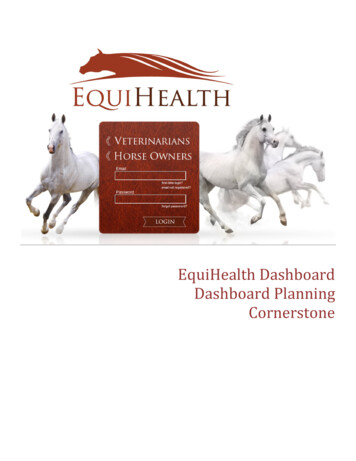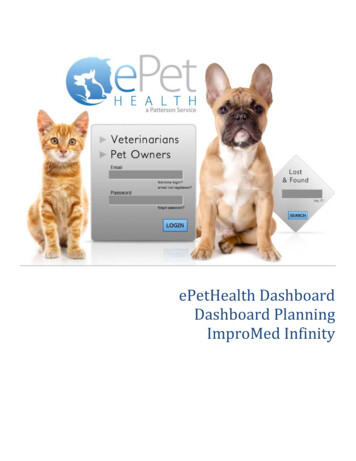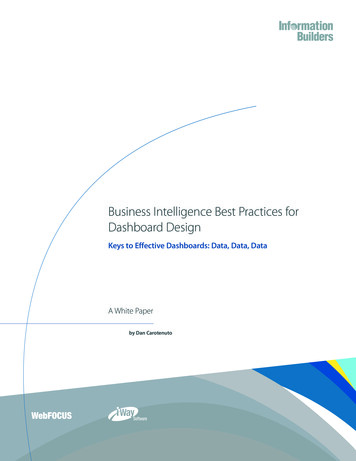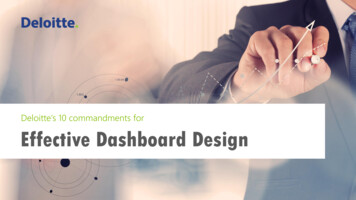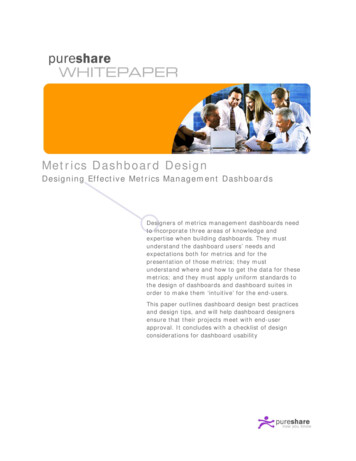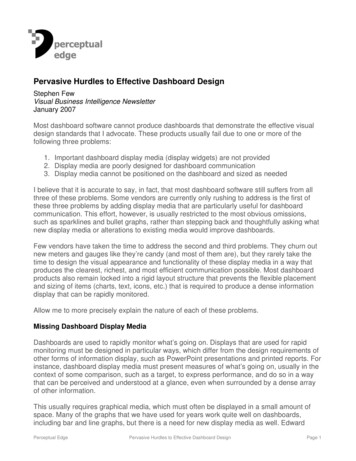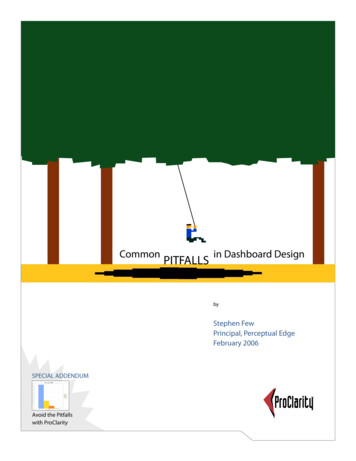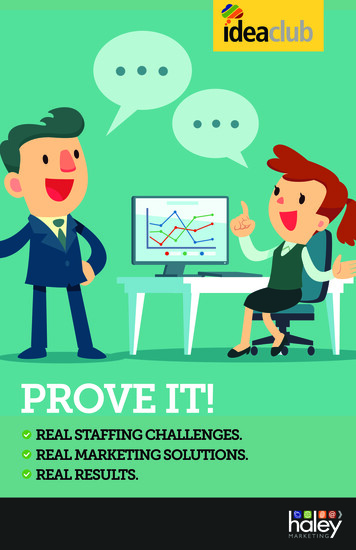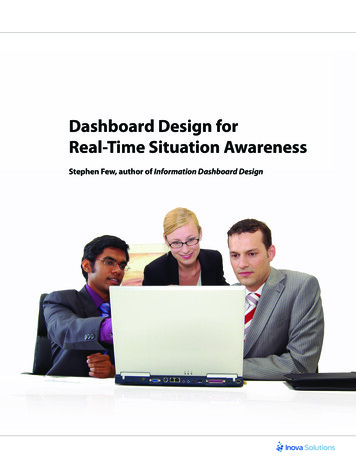
Transcription
Dashboard Design forReal-Time Situation AwarenessStephen Few, author of Information Dashboard Design
Dashboard Design for Real-Time Situation AwarenessFew if any recent trends in business information delivery have inspired as muchenthusiasm as dashboards. When they work, they provide a powerful means to tamethe beast of data overload. Despite their popularity, however, most dashboards live upto only a fraction of their potential. They fail, not because of poor technology—at leastnot primarily—but because of poor design. The more critical that information is to thewell being of the business, the more grievous is the failure, because the remedy is soreadily available.The term “dashboard” refers to a single screen information display that is used tomonitor what’s going on in some aspect of the business. The key word is “monitor.”A dashboard presents the key data that you must efficiently monitor to maintainawareness of what’s going on in your area of responsibility. Most dashboards areused to monitor information once a day, because more frequent use is unnecessarygiven the rate at which the information changes and speed at which responsesmust be made. Some jobs, however, require constant monitoring in real time, orclose to it, because the activities that you track are happening right now and delaysin responding can’t be tolerated. There is perhaps no better example of this type ofdashboard than one that monitors the brisk and sometimes harried activities of a callcenter.Much like air traffic control systems or cockpits in airplanes, call center dashboardsmust be designed to support real-time “situation awareness.” They must grab yourattention when it’s needed, they must make it easy to spot what’s most important in ascreen full of data, and they must give you the means to understand what’s happeningand respond without delay. To do this, they require expert visual design and mustexpress measures of performance clearly, accurately, directly, and without distraction.I’ve written an entire book about the visual design of dashboards in general, entitledInformation Dashboard Design: The Effective Visual Communication of Data. Mypurpose in this white paper is not to repeat in summary form what I’ve already done,but rather to narrow and sharpen my focus on the specific design requirements ofdashboards that are used to maintain real-time situation awareness. I am approachingthis task with an eye on call center monitoring as an example of how the principlesand practices that I advocate can be applied to solve a real-world challenge.Situation AwarenessAlthough not all situations require ongoing moment-to-moment awareness, the term“situation awareness” is normally reserved for situations that do. There is an excellent2
Dashboard Design for Real-Time Situation Awarenessbook about situation awareness and how to design systems to support it entitledDesigning for Situation Awareness. It defines the term as follows:Basically, situation awareness is being aware of what is happening around youand understanding what that information means to you now and in the future.This awareness is usually defined in terms of what information is important fora particular job or goal. The concept of situation awareness is usually appliedto operational situations, where people must have situation awareness for aspecified reason, for example in order to drive a car, treat a patient, or separatetraffic as an air traffic controller.(Mica R. Endsley, Betty Bolte, and Debra G. Jones, Designing for Situation Awareness:An Approach to User-Centered Design, 2003, Taylor and Francis, New York, page 13)This term was first used in relation to military pilots, when aviation was still relativelynew and the ability of pilots to keep track of what was going on around them was amatter of life or death. As the definition above suggests, this involves three levels ofawareness:1) the perception of one’s environment,2) comprehension of its meaning, and3) the projection of that understanding into the future to anticipate what mighthappen.A dashboard that is designed to support situation awareness must support all threelevels of awareness. Failure in any of these areas will undermine the effectiveness ofthe dashboard. The entire weight of responsibility for the success or failure of thedashboard, however, does not fall on the dashboard alone. The person who usesthe dashboard must thoroughly understand the domain. She must have alreadyconstructed a mental model of the domain into which the information derived fromthe dashboard can be rapidly integrated. A perfectly designed dashboard will notovercome her lack of expertise, and her expertise cannot overcome the failures of thedashboard to present information in a way that matches her mental model.Why Dashboards?When they are properly designed, dashboards can provide a powerful means tomonitor what’s going on at a glance. Two characteristics of a dashboard are largelyresponsible for this ability: 3Their visual natureThe way they integrate everything you must keep track of, however disparate,onto a single screen
Dashboard Design for Real-Time Situation AwarenessThe Power of Visual PerceptionDespite the richness of our sensory abilities, spread across five wonderful senses, all ofwhich I immeasurably cherish, we perceive the world primarily through our eyes. Ofall the sense receptors in the human body, 70% reside in the retinas of our eyes. Thereis such an intimate connection between what we see and how we think, we actuallyuse the expression “I see” as a substitute for “I understand.” When we make sense ofsomething, we refer to what we’ve learned as “insight.”Vision not only dominates our senses by sheer numbers, it is also faster, basedon bandwidth of input, and richer. Unless you are visually impaired, an auditorypresentation of the same information that resides on a dashboard would take muchlonger to input, and after listening to it all, your understanding of the informationwould never come close to the picture that takes shape in your mind when it iscommunicated visually. And I’m not talking about a dashboard that takes the samewords that could be spoken and presents them as text on the screen. Althoughdelivered through the visual channel, the medium of expression is still verbal, based onlanguage, rather than images. Any dashboard will include words, which are the best oronly way to communicate many concepts, but the more that you can rely on imagesto tell the story, the faster that story can be perceived. We perceive images in a parallelmanner (lots of information all at once), which is much faster than the serial perceptionof language.The old saying that “a picture is worth a thousand words” is absolutely true whenthe information can be expressed as an image and the image clearly represents theinformation. For example, look at the table in Figure 1 of call volumes for two callcenters across 12 months.Figure 1: A tabular display of call volume data.Even though this table only presents 24 values, reading them takes time andtranslating them into a picture of how these values compare and how they changethrough time is difficult.4
Dashboard Design for Real-Time Situation AwarenessNow, in Figure 2, here’s the same exact information displayed as a simple line graph.Figure 2: The same call volume data as before, but presented in a way that bringspatterns, trends, and exceptions to light.You can immediately and with little effort perceive a great many facts about callvolume that jump out at you from this graph and you can hold the picture in yourhead if you wish. This is the power of visual perception. Whenever the information canbe presented on a dashboard in graphical form, we should grab the opportunity.To do this effectively, you must understand a bit about visual perception andcognition: how we see and how our brains make sense of what we see. This is notthe place to go into this topic, but rest assured that you don’t need to be a scientistto learn the simple lessons about visual perception that are required to become anaccomplished dashboard designer.The Benefits of Bringing Information Together Within Eye SpanOne of the reasons that visual representations of information are so useful forunderstanding is that they help us work around a fundamental limitation that isbuilt into each one of our brains. Although we have tremendous long term memorycapacity, short term memory (a.k.a., working memory) is extremely limited. Short termmemory is the temporary place that information is stored for immediate access whilewe’re thinking about things. Information gets into short term memory in two ways:1) from our senses (such as our eyes), and 2) from long term memory. When you arethinking about something that you are experiencing at the moment in the world, suchas a presentation that you’re listening to, selected information that you hear movesinto short term memory for a moment, and as you consider it, you might draw onpast memories that seem related in some way, bringing them into short term memory5
Dashboard Design for Real-Time Situation Awarenessbriefly to assist in the thought process. You might find it surprising to know that shortterm memory can only hold approximately four chunks of information at any one time.A chunk of information is the amount that you can store in a single slot of memory. Ifyou are reading a table of numbers, such as the one in Figure 1, once you take youreyes off of it, at most you will only remember four or five of the numbers, one per slotof memory. If, however, you look at the line graph, you can store the entire patternformed by the shape of a line (that is, 12 monthly values) as a single chunk of memory.When quantitative information is displayed in visual form in a simple manner that wecan easily see and in a way that meaningfully represents the values, such as a line thatgoes up and down to represent the rise and fall of values through time, we can storemuch more information within the confines of short term memory than we couldif the values were written as numbers. Simply by encoding information visually, ourability to think about it can be significantly expanded by making more of it available atany one moment.By placing all of the information that you need to monitor (at least at a high level) on asingle screen, simultaneously available to our eyes, we work around the limitations ofshort term memory by reducing the need to rely on it. If the information is right therein front of your eyes in the form of a dashboard, the dashboard serves as an externalform of memory. You don’t need to memorize the information (that is, to move it intolong term memory where it will remain for years), because it’s right there in front ofyour eyes, where it can be rapidly moved in and out of short term memory at lightningspeed as you make sense of it. Ideally, you want the dashboard to include everythingthat you need to monitor for rapid processing.Design Problems You Should AvoidIt is worthwhile to note some of the most common and costly problems that youshould avoid when designing a real-time operational dashboard. Let’s look at thefollowing problems, one at a time: 6Too much complexityToo many alert conditionsAlerts that cannot be differentiatedOverwhelming visualsDistracting visualsInappropriate visual salienceMismatch between information and its visual representationIndirect expression of measuresNot enough context
Dashboard Design for Real-Time Situation AwarenessToo much information or complexityMost dashboards can display a great deal of information without overwhelming thosewho use them due to excessive information or complexity. Real-time dashboardsthat must be monitored frequently and responded to quickly at a moment’s notice,however, must be somewhat simpler. I’m not suggesting that you display only ahandful of items on the dashboard—it’s amazing how much information we canquickly assimilate from a properly designed dashboard—but the high level ofinformation density that works quite well for dashboards that people view once a dayand respond to without urgency would exceed the practical perceptual limits of realtime monitoring.Aside from the amount of information, the level of complexity that works on adashboard depends entirely on the expertise of those who use it. A chart that wouldoverwhelm and confuse some people might seem simple to others, because it’sfamiliar and they know what to look for. In other words, appropriate boundaries for thelevel of complexity cannot be established arbitrarily or generally; where the lines aredrawn depends entirely on the audience.Don’t display more information on the dashboard than the amount that can be quicklyscanned and understood. How much is too much depends a great deal on how youpresent it. I’ve seen displays that could not be scanned and understood in any amountof time, even though they contained no more than a handful of measures, becausethey were poorly designed. If a chart is difficult to read, no reduction in the amountof information will change that fact, but when properly designed, 10,000 values cansometimes appear in a single chart in a way that is easy to read and understand.Too many alert conditionsWhen’s the last time you paid any attention to a car alarm other than to get annoyed.If alarms go off often but rarely require a response, people soon learn to ignore them.Because the conditions that set off car alarms have always been too liberal, mostlythrough ineffective design, they rarely serve their intended purpose. Be conservativewhen determining the conditions that trigger alarms. Don’t demand immediateattention to circumstances that can wait.Only use visual or auditory means to draw attention to information that urgentlyrequires a response. If things are fine, you don’t need to draw attention to the fact. Forexample, I’ve seen many dashboards that use color coding to score every single itemon the dashboard as good, satisfactory, or bad. When this is done, the abunda
Information Dashboard Design: The Eff ective Visual Communication of Data. My purpose in this white paper is not to repeat in summary form what I’ve already done, but rather to narrow and sharpen my focus on the specifi c design requirements of dashboards that are used to maintain real-time situation awareness. I am approaching this task with an eye on call center monitoring as an example .File Size: 2MBPage Count: 23
